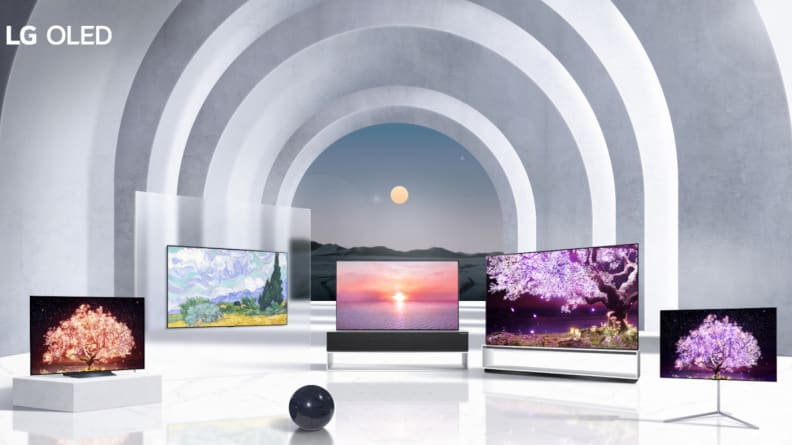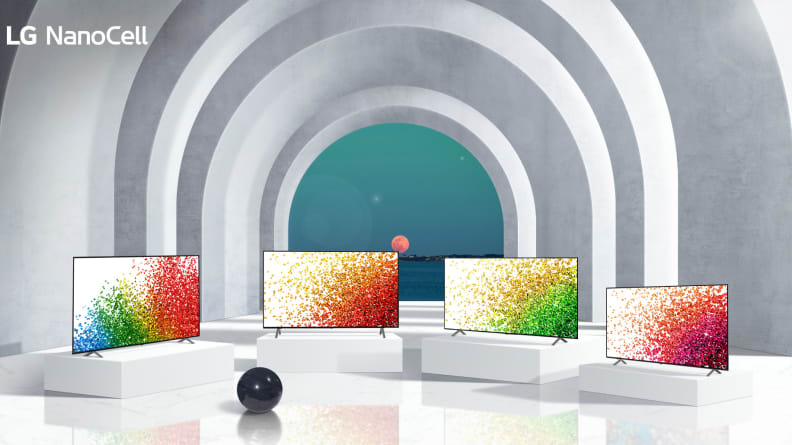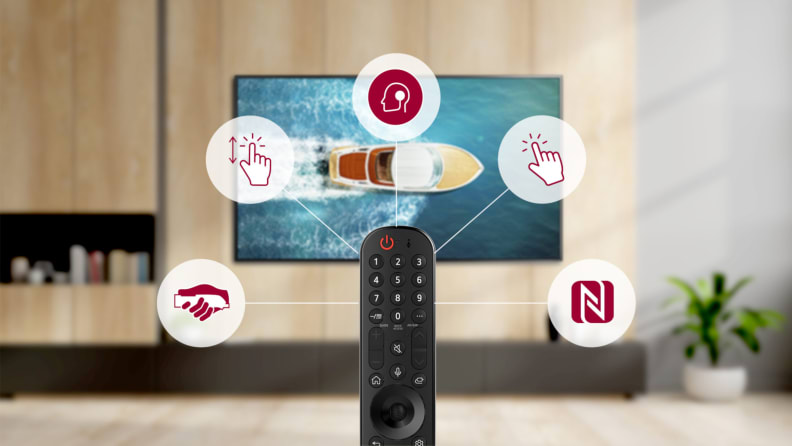LG BRIGHTENS ITS OLEDS, TEASES BRAND NEW TV TECH FOR CES
LG's OLEDs get brighter, while its LEDs get myriad upgrades.
CES 2021 is a virtual affair this year, but the world's biggest tech companies are still taking bringing their best and brightest to the bear. For its part, LG today announced the next "evolution" in OLED TVs, currently the hottest display technology on the market.
During its press event for CES 2021's Media Day, LG unveiled a bevy of exciting home theater upgrades, not the least of which is "OLED evo," the current moniker for LG's upgraded and improved lineup of 2021 OLED TVs. In addition, LG showed off its new NanoCell LED TV options, soundbars, speakers, and headphones.

LG's new "OLED evo" promises brighter OLED TVs with a suite of improvements.
...LG debuted its first OLED TVs in 2013, and considered the first "evolution" to take place in 2015 when its OLED TVs were upgraded for High Dynamic Range capabilities.
The second "evolution," which LG is calling OLED evo in 2021, promises higher brightness (luminance), optimized "composition," and more precise OLED element wavelengths.
Unfortunately, we're not exactly sure how LG has achieved that yet, nor what it will ultimately mean for your viewing experience. The 2020 models generally peaked around 700 or 800 nits, which means they're about twice as bright as an entry-level TCL QLED TV, but about half as bright as one of Samsung's high-end QLED TVs.
Brightness is important for almost all TV functions: dynamic range, color saturation, viewing angle (to a degree), and combating ambient lighting in most rooms. In fact, it may be that increasing brightness is the only way LG's OLEDs (or any OLED TVs) will continue to maintain a competitive advantage over LED/LCD TVs in 2021, which—outfitted with mini-LEDs and quantum dot tech—are looking better than ever.
Whether the "evo" panels will introduce a remarkable increase in brightness remains to be seen (literally—we're not on the CES show floor at all this year), but it's an exciting prospect. Fortunately, LG has at least shed some light on its new OLED lineup:
G1: The G1 LG OLED series replaces the 2020 GX series, and is one of the first confirmed models to use the new evo panel specs. It will be available in 55, 65, and 77 inches, and also utilize LG's new A9 Gen 4 processor (more on that below);
C1: The new C1 replaces last year's CX (currently our top-rated television), and is available in a huge range of sizes: 48, 55, 65, 77, and 83 inches. These TVs will also use the A9 Gen 4 processor, but it's unclear if they'll have the evo panel upgrade.
A1: Replacing its longstanding "B" models, the A1 are the new most affordable series in LG's 2021 OLED TV lineup. The A1 OLEDs will be available in 48, 55, 65, 77, and 83-inch variants, and will use the older A7 processor. It's doubtful these TVs will utilize the evo panel, but we're not 100% certain yet.
ZX: This TV debuted in 2020, but will still be available in 2021. This is one of the first 8K OLED TVs available for purchase, and comes in huge 77 and 88-inch sizes. The 77-inch is $20,000, and we don't even want to know what the 88-inch model costs.
Naturally, we don't have pricing or availability info for the 2021 models just yet, but check back for updates in the coming weeks.
NanoCell is getting better, too

LG will offer a wide variety of NanoCell options in 2021.
We definitely get more excited about LG's OLED TVs than any of the company's LED/LCD models, and during a private presentation LG made sure to emphasize that none of its NanoCell TVs could compete with its prized OLEDs from a picture standpoint. That said, LG is still making improvements to its LED TVs, and in fact is calling the new NanoCell models "Nano Evo." It's an evo year, apparently.
LG claims huge brightness jumps for the new Nano Evo TVs. Recalling that last year's OLEDs topped out around 800 nits, LG is claiming that its Nano Evo models will hit a wild 3,000 nits—an impressive and striking number if true...
The "NanoCell" TVs are so-named because they use an organic film layer within the "LCD sandwich," but while it may operate like quantum dots, this isn't technically the same thing. They're also using mini-LEDs (like any respectable LED TV this year), which might be how they propose to hit that 3,000 nit benchmark. Will 2021 be the year LG's LED TVs make as many waves as the company's OLED televisions? Maybe so.
A new venture: QNED Mini-LED

LG's new QNED lineup is the company's first foray into quantum dot mini-LED.
LG debuted its new QNED TV lineup ahead of CES last week, but the gist is simple enough: LG is finally throwing its hat in the ring in terms of combining LED TVs utilizing Mini-LED backlights with quantum dot color (reminder: the NanoCell models don't and haven't been using quantum dot since their inception a few years back).
If a combination of quantum dot and mini-LED sounds familiar, it's probably because that's more or less exactly what you're getting from Samsung's 2021 QLED lineup. Still, that doesn't make the availability of more extra-bright, extra-colorful LED TVs any less exciting.
Considering the proprietary nature of LG's nano organic (NanoCell) technology, the QNED line should be the first TVs to ever combine quantum dots and NanoCell, which may make for some very fancy-looking LED TVs. LG still doesn't think the QNED TVs will look as good as its OLED line, but hey, we'll be the judge of that...
Magic Remote, webOS, and more

LG is also bringing improvements for webOS, the Magic Remote, and gamers.
Naturally, LG announced a lot more than new OLED and NanoCell LED TVs. Last week, LG announced improvements to its webOS smart platform and Magic Remote, the new A9 Gen 4 processor, and upgrades meant for gamers...
https://www.reviewed.com/televisions/features/lg-new-oled-nanocell-qned-tvs-2021is that time of the year again where ces is introducing a lot of new and interesting technologies to us consumers. because of the corona virus, this year ces will be announced digitally instead of hand on experience for show goers.
its good to hear that this year oled tv gets brighter than last year. the strange thing is when lg first sell its 4k oled tv with hdr and wcg in 2016, its can get as bright as 800 nits. then a year later, the 2017 model gets 25% brighter than its previous year which mean a total of 1,000 nits brightness. but last year's model, its get dimmer than its previous few years. its only get as bright as around 600 to 700 nits of brightness. strange. its a conspiracy i say. makes me wonder how bright this year's oled going to get. i hope its surpasses 1,000 nits of brightness.
i already bought an oled tv late last year and one of the suckiest thing about it is its not as bright as 2016 or 2017 models, and this year's model. i can live with that, its still pretty bright though.
also good to hear that lg is selling nanocell tvs and some models can get as bright as 3,000 nits. sure its still lcd screen, but the brightness is pretty awesome. great for hdr.